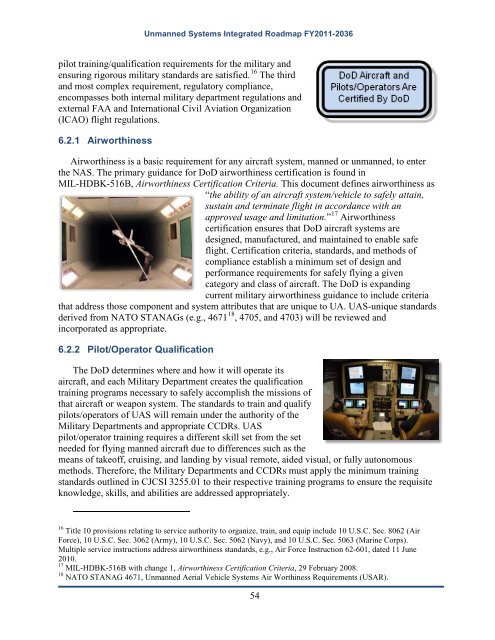Unmanned Systems Integrated Roadmap FY2011-2036 - Defense ...
Unmanned Systems Integrated Roadmap FY2011-2036 - Defense ...
Unmanned Systems Integrated Roadmap FY2011-2036 - Defense ...
Create successful ePaper yourself
Turn your PDF publications into a flip-book with our unique Google optimized e-Paper software.
<strong>Unmanned</strong> <strong>Systems</strong> <strong>Integrated</strong> <strong>Roadmap</strong> <strong>FY2011</strong>-<strong>2036</strong><br />
pilot training/qualification requirements for the military and<br />
ensuring rigorous military standards are satisfied. 16<br />
The third<br />
and most complex requirement, regulatory compliance,<br />
encompasses both internal military department regulations and<br />
external FAA and International Civil Aviation Organization<br />
(ICAO) flight regulations.<br />
6.2.1 Airworthiness<br />
Airworthiness is a basic requirement for any aircraft system, manned or unmanned, to enter<br />
the NAS. The primary guidance for DoD airworthiness certification is found in<br />
MIL-HDBK-516B, Airworthiness Certification Criteria. This document defines airworthiness as<br />
“the ability of an aircraft system/vehicle to safely attain,<br />
sustain and terminate flight in accordance with an<br />
approved usage and limitation.” 17 Airworthiness<br />
certification ensures that DoD aircraft systems are<br />
designed, manufactured, and maintained to enable safe<br />
flight. Certification criteria, standards, and methods of<br />
compliance establish a minimum set of design and<br />
performance requirements for safely flying a given<br />
category and class of aircraft. The DoD is expanding<br />
current military airworthiness guidance to include criteria<br />
that address those component and system attributes that are unique to UA. UAS-unique standards<br />
derived from NATO STANAGs (e.g., 4671 18<br />
, 4705, and 4703) will be reviewed and<br />
incorporated as appropriate.<br />
6.2.2 Pilot/Operator Qualification<br />
The DoD determines where and how it will operate its<br />
aircraft, and each Military Department creates the qualification<br />
training programs necessary to safely accomplish the missions of<br />
that aircraft or weapon system. The standards to train and qualify<br />
pilots/operators of UAS will remain under the authority of the<br />
Military Departments and appropriate CCDRs. UAS<br />
pilot/operator training requires a different skill set from the set<br />
needed for flying manned aircraft due to differences such as the<br />
means of takeoff, cruising, and landing by visual remote, aided visual, or fully autonomous<br />
methods. Therefore, the Military Departments and CCDRs must apply the minimum training<br />
standards outlined in CJCSI 3255.01 to their respective training programs to ensure the requisite<br />
knowledge, skills, and abilities are addressed appropriately.<br />
16 Title 10 provisions relating to service authority to organize, train, and equip include 10 U.S.C. Sec. 8062 (Air<br />
Force), 10 U.S.C. Sec. 3062 (Army), 10 U.S.C. Sec. 5062 (Navy), and 10 U.S.C. Sec. 5063 (Marine Corps).<br />
Multiple service instructions address airworthiness standards, e.g., Air Force Instruction 62-601, dated 11 June<br />
2010.<br />
17 MIL-HDBK-516B with change 1, Airworthiness Certification Criteria, 29 February 2008.<br />
18 NATO STANAG 4671, <strong>Unmanned</strong> Aerial Vehicle <strong>Systems</strong> Air Worthiness Requirements (USAR).<br />
54

















